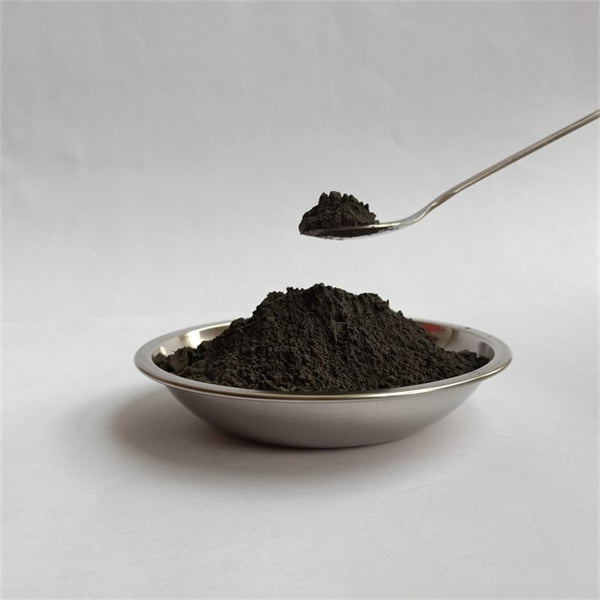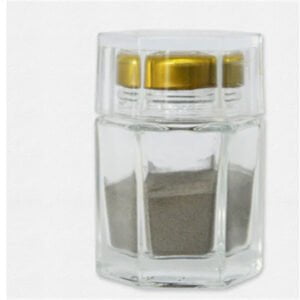Nickel Silver Powder
Table of Contents
Nickel silver powder is a specialized metal powder with unique properties and diverse applications across industries. This metallic material offers superior strength, durability, corrosion resistance, electrical conductivity, and workability compared to other alloy powders.
Overview of Nickel Silver Powder
Nickel silver, also known as German silver, Argentan, or nickel brass is an alloy composed of copper, nickel, and zinc. Nickel silver contains no elemental silver but gets its silvery appearance from the nickel content. The nickel alloy powder has distinct advantages that make it suitable for use in electronics, decorative parts, automotive components, jewelry, musical instruments, and more.
Key properties and characteristics:
- Composition: 60-80% copper, 5-30% nickel, up to 20% zinc
- Density: 8.3 – 8.8 g/cm3
- Melting point: 890 – 1000°C depending on exact composition
- Electrical resistivity: 15 – 25 μΩ.cm
- High strength and hardness
- Excellent corrosion resistance
- Good brazing and soldering ability
- Machinability better than brass or nickel alloys
- Lower material costs than silver or gold
Nickel silver powder specs:
- Particle sizes: 1 – 150 microns
- Morphology: spherical, irregular, dendritic, flux-coated
- Purity: Up to 99.9+%
- Fineness: Up to 100 mesh size
- Apparent density: Typically 2 – 5 g/cm3
- Flow rate: 25-35 s/50g
Alloy grades and types:
The alloy composition can be varied to obtain different mechanical properties, color, and performance. Some standard nickel silver alloy powder compositions are:
- 65% Cu, 18% Ni and 17% Zn
- 60% Cu, 20% Ni and 20% Zn
- 70% Cu, 15% Ni and 15% Zn
- Special low/high nickel varieties
Global production:
China is currently the largest producer and exporter of nickel silver powder to the world, followed by India, Korea, European countries like Germany, and the United States.

Manufacturing Processes
Nickel silver alloy powder can be manufactured by various methods with unique characteristics imparted by each production technique.
Key manufacturing processes:
- Water atomization – High purity, spherical powders for additive manufacturing
- Gas atomization – Finer control of size distribution
- Electrolysis – Dendritic, highly porous flakes with very high surface area
- Carbonyl – Spherical powders with smooth surface, low oxygen content
- Milling – Irregular shaped powders by mechanical crushing
- Precipitation – Ultrafine nano-crystalline powders
Additionally, the powders may undergo proprietary modifications and coatings such as:
- Lubricant coatings for improved powder flow
- Surface activation for better sintering
- Anti-oxidant treatments
- Granulation with binders
- Blending with other alloy powders
These processes allow nickel silver powders with customized sizes, shapes, porosity, flowability, and microstructure suitable for different production methods.
Applications of Nickel Silver Powder
Nickel silver alloy powders find use across diverse industries owing to their excellent combinational properties. Some major application areas include:
Additive Manufacturing
- 3D printing of functional prototypes and end-use parts with fine details and complex geometries not possible by other methods
- SLS and binder jetting are popular techniques using nickel silver powder feedstock
Benefits: High resolution, geometric flexibility, speed, lightweight parts with superior properties
Electronics
- Conductive adhesives, pastes, and solders for printed circuit boards, semiconductors and microelectronics
- EMI/RFI shielding components
- Vacuum metallization targets
Benefits: Excellent electrical conductivity, protects components from interference
Automotive and Aerospace
- Manufacture of precision small components like valves, switches, regulators, turbocharger parts
- Decorative trim parts, logos, badges, nameplates
- Cost-effective alternative to solid precious metals
Benefits: Corrosion resistant, attractive finish, withstands high temperatures
Jewelry and Luxury Goods
- Highly realistic precious metal reproductions
- Silver-colored jewelry findings, chains, beads and metal crafts
- Decorative items with gold/silver appearance at a fraction of the cost
Benefits: Excellent tarnish/fire scale resistance, economical alternative to noble metals
Musical Instruments
- Manufacturing of brass and silver-colored instruments like trumpets, saxophones, flutes, trombones
- Decorative parts, keys, springs and ornamental fixtures
Benefits: Acoustic properties close to brass, attractive warm appearance
Some other niche industrial uses:
- Welding wires and brazing alloys
- Silver-colored mirrors, reflectors
- Anodes for cathodic protection of marine structures
- Special magnets and magnetic shielding
- Silver-colored porcelain/glass coatings
- Antimicrobial medical instruments and implants
Suppliers and Pricing
Nickel silver alloy powders are commercially available from specialist global suppliers and manufacturers at competitive rates.
| Supplier | Location | Description | Price Range |
|---|---|---|---|
| Makin Metal Powders | UK | Broad range of nickel silver powders, sizes 10-150 um | $25-40/Kg |
| Sandvik Osprey | UK | Gas atomized powders, excellent quality | $30-60/Kg |
| Hoganas | Sweden | Pioneer in silver alloy powders, wide range | $15-50/Kg |
| AMETEK | USA | Custom alloys and coatings | $40-100/Kg |
| SCM Metal Products | Canada | Water atomized powders | $20-50/Kg |
| Shanghai CNPC | China | High purity electrolytic powders | $15-25/Kg |
Pricing can vary based on:
- Purity levels
- Particles sizes and distribution
- Morphology and microstructure
- Purchase volumes and long term contracts
- Level of customization for properties and applications
Cost comparison with alternatives:
- More economical than silver or gold powders
- Higher than copper and nickel metal powders
- Lower raw material costs than many exotic alloys
Contact the reputable suppliers above for price quotes, customization options, and buying nickel silver powders suitable for your production requirements.
Pros and Cons of Nickel Silver Powder
Advantages
- Excellent strength and hardness – better than individual metals
- Higher corrosion and tarnish resistance than copper or silver
- Attractive white color and metallic shine
- Good stability at elevated temperatures
- Superior workability than nickel alloys
- Excellent electrical conductivity, about 50% that of pure copper
- Less prone to dezincification than brass alloys
- Lower density than silver makes it suitable for weight reduction
- More ductile and cheaper alternative to stainless steel
- Easy to fabricate components with intricate details
Limitations
- Not recommended for high temperature structural load bearing applications over 250°C
- Susceptible to stress corrosion cracking from ammonia-based cleaning solutions
- Requires protective gas shielding during laser cutting to prevent oxidation
- Surface finishes may not be as lustrous as pure silver
- Limited use in food contact and medical devices due to nickel content
- Not suitable for high pressure steam and thermal cycling conditions
- Strong acids and bases can still cause corrosion over time
- Powder surface oxidation during long term storage
Nickel Silver vs Alternatives
Nickel silver powders offer an optimum balance of properties and performance at relatively lower price points compared to common alloy alternatives:
| Parameter | Nickel Silver | Brass | Bronze | Stainless Steel |
|---|---|---|---|---|
| Strength | Excellent | Good | Excellent | Excellent |
| Hardness | Excellent | Fair | Good | Better |
| Wear resistance | Good | Poor | Good | Best |
| Corrosion resistance | Excellent | Good | Moderate | Best |
| Conductivity | Excellent | Good | Poor | Poor |
| Workability | Excellent | Excellent | Good | Poor |
| Cost | Low | Low | High | High |
Key Takeaways:
- Nickel silver outperforms brass and bronze for strength and conductivity
- Comparable hardness to stainless steel but at lower metal prices
- Superior corrosion resistance to copper alloys
- Better workability than stainless steel or nickel superalloys
- Excellent combinational properties with moderate cost
Quality Control and Standards
Like any metallic material, nickel silver alloy powders must meet strict industrial quality control guidelines for composition, microstructure, particle characteristics, impurity levels, and other properties.
Common tests conducted:
- Chemical analysis using optical emission or X-ray fluorescence spectroscopy to determine elemental composition and confirm it meets specified alloy grades. Detection limit in ppm range.
- Microstructure analysis through optical and electron microscopy to reveal particle shape, grain size, phases present.
- Particle size distribution using laser diffraction or sieving. Quantifies powders into different size fractions.
- Apparent/tap density measurements in g/cm3 based on standard test methods. Indicates flow and compaction properties.
- Flow rate measurements in s/50g using Hall or Carney funnel tests. Important for feedstock powders.
- Surface area quantification in m2/g by nitrogen adsorption/desorption isotherms (BET method). Measures porous and non-spherical powder morphologies.
- Impurities testing through ICP-MS, GD-OES down to ppb levels. Verifies permissible limits of elemental contaminants.
- Custom tests like hydrogen analysis, loss on ignition, gas analysis for individual applications
Nickel silver powder compositions and properties are standardized globally by organizations such as:
- ASTM B739 – Standard specification for nickel silver casting alloys
- DIN 17665 – Chemical compositions of Cu-Zn-Ni alloys
- JIS H3110 – Japanese standard on nickel silver plates, sheets and strips
- UNS C75700-C77600 – Unified numbering system for nickel silver copper alloys
Reputable powder suppliers provide compliance certificates to these specifications upon request. Customers can request additional verification testing for highly regulated applications.

FAQ
Q. Is nickel silver powder toxic? Is it safe to handle?
A. Nickel silver alloys contain nickel which is classified as a skin sensitizer. Inhalation of fine powders can potentially cause respiratory irritation. However, the alloy powder is generally considered safe to handle with proper protective equipment like gloves, masks, eye protection per OSHA safety guidelines. Any dust exposure and ingestion risks can be easily controlled during handling and processing.
Q. Why is it called nickel silver if there is no silver?
A. Nickel silver is named so because of its silver-white appearance resembling pure silver. The nickel provides the shiny white look while being much more affordable than actual silver. It does NOT contain any elemental silver. The ratio of copper, nickel and zinc is varied to achieve different mechanical and electrical properties.
Q. Is nickel silver powder ferromagnetic?
A. While nickel and iron are ferromagnetic metals, standard nickel silver alloys with 60-80% copper content are non-magnetic much like pure copper. Only special nickel silver compositions very low in copper demonstrate ferromagnetic behavior.
Q. Does nickel silver powder require special storage?
A. Like any fine metal powder, nickel silver alloys can be sensitive to moisture and air exposure. For best shelf life, store sealed containers in a cool, dark, and dry location away from temperature extremes. Inert gas blanketing is recommended for long-term storage to prevent oxidation especially for high purity powders.
Q. What is the difference between nickel silver and German silver alloy?
A. The terms nickel silver and German silver actually refer to the same family of copper-nickel-zinc alloys. They exhibit a bright, silver-white appearance while containing no elemental silver. So nickel silver powder = German silver powder from composition and properties perspective. The “German” tag comes from early 19th century silverware made using this alloy in Germany.
Share On
MET3DP Technology Co., LTD is a leading provider of additive manufacturing solutions headquartered in Qingdao, China. Our company specializes in 3D printing equipment and high-performance metal powders for industrial applications.
Inquiry to get best price and customized Solution for your business!
Related Articles
About Met3DP
Recent Update
Our Product
CONTACT US
Any questions? Send us message now! We’ll serve your request with a whole team after receiving your message.

Metal Powders for 3D Printing and Additive Manufacturing
COMPANY
PRODUCT
cONTACT INFO
- Qingdao City, Shandong, China
- [email protected]
- [email protected]
- +86 19116340731

















